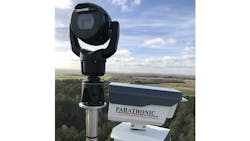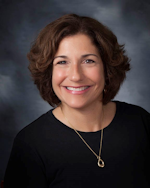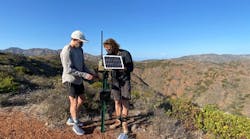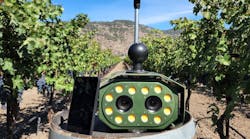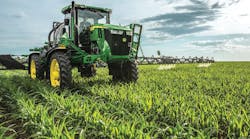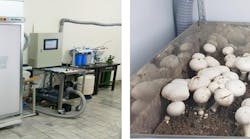Wildfires erupt in France, as is the case throughout Europe, during the warm summer months.
The risk of these fires occurring has increased in recent years because of climate change and, in fact, more fires have occurred. A total of 65,660 hectares of forest and wildlands burned in France in 2022, compared with an average of 9,825 hectares from 2006-2021, according to Statista (NY, NY, USA; www.statista.com.)
That is why the SDIS72, or Service Départemental d'Incendies et de Secours de la Sarthe, (Coulaines, France; www.sdis72.fr) located in the Northwest quadrant of France, implemented an automated fire detection and information management system, beginning in 2020, based on machine vision and deep learning. The district oversees the most densely forested region in Northwest France with 117,000 hectares of forest.
Before implementing an automated solution, the fire department made do with a hit-or-miss strategy of human observation by a single person stationed at a height of 30 or 40 m above ground in a watchtower. It was a risky undertaking for the human observers. During their several-hour shift, they would be exposed to the risk of lightning strikes and radiofrequency fields from nearby GSM relay antennas.
The automated system—Alert Detection Localization of Forest Fires, or ADELIE—was developed by PARATRONIC (Reyrieux, France; www.paratronic.com/en/), a company that specializes in developing and marketing electronic systems to manage public water systems or prevent natural disasters, such as forest fires.
“The doctrine of the French fire brigade is to attack any fire in a dynamic and massive way in order to limit its development as much as possible. A monitoring system such as ADELIE allows the fire brigade to be warned as soon as the first smoke appears, and therefore to be alerted as soon as possible, and to send correctly sized resources as quickly as possible to a perfectly located site,” says Edouard Bouillot, Director of Projects and Innovation at PARATRONIC.
SDIS72 is one of seven French fire departments using the ADELIE system.
SDIS72 chose the system after a formal public tender, or RFP, process. “The capabilities and results of the ADELIE system, developed over 15 years in conjunction with its users, led the SDIS72 to choose the ADELIE system,” explains Bouillot.
Machine Vision System
ADELIE detects the presence of smoke through surveillance points that are networked together. Line scan cameras and a video camera are installed at each surveillance point. SDIS72 personnel use the video camera, which is equipped with a 30x optical zoom, to confirm the presence of smoke once it is detected by the automated system, which relies on the line scan cameras.
The ADELIE system can integrate with any video camera and is currently using a model from Bosch. (Stuttgart, Germany; www.bosch.com/)
At each surveillance point, PARATRONIC installs two detection cameras that comprise four Gigabit Ethernet cameras from IDS Imaging Development Systems GmbH (Obersulm, Germany; https://en.ids-imaging.com/), totaling eight IDS cameras per surveillance point.
The camera—UI-5240SE-NIR-GL from the uEye product line—is fitted with a 1.3-MPixel CMOS sensor from Teledyne e2v (Chelmsford, Essex, UK; www.teledyne-e2v.com/en/home/).
Each of the surveillance points observes an area with a radius of up to 20 km, taking two minutes to monitor a 360-degree radius. The system works 24 hours a day and seven days a week. There are 16 surveillance points in the system.
The system takes 13,500 images per surveillance site per day in the forested area overseen by SDIS72 and stores the images (even if smoke is not detected) for 30 days. All images—even those in which fire was not detected—are transmitted over an Internet Protocol (IP) network in real time. The images are available in JPEG so members of the SDIS72 team can review them on a computer monitor.
Detecting Smoke
To analyze the images for smoke, PARATRONIC-developed deep-learning algorithms compare two images taken at the same orientation to detect the presence of smoke.
To do this, the images are registered to the 50th of a degree. The images are then compared, focusing on such changes as movement, displacement of an object, or the appearance of smoke.
Other algorithms carry out an automatic check to ensure that the smoke is not coming from a known source, such as a factory’s chimney.
Once the analysis is complete and smoke is confirmed, the images and associated data (camera number, viewing angle, date, and time taken) are transmitted to a computer in the SDIS72 control center. By integrating data from a weather station, information such as wind speed and precipitation also are transmitted.
In addition to transmitting data, the system triggers an alarm at connected workstations located in SDIS72’s control center. An operator then confirms visually the presence of a fire using the feed from the video camera and, once confirmed, passes the information about the fire to the department’s intervention teams. The operator and fire officials also can use the video to monitor the situation until firefighters arrive on the scene and then throughout the intervention.
If more than one tower has detected smoke, control center operators use ADELIE’s supervision software to determine the exact location of the source of the fire on a digital map. This is done using triangulation—a surveying method in which a specific point is located by measuring the angles to it from other known points.
Challenges
“Detection in the natural environment has to face multiple technical challenges such as light, distance, weather conditions, the natural environment moving and changing with the seasons, and the appearance or disappearance of objects, [such as] vehicles,” Bouillot says.
The team has addressed these challenges, in part, through the selection of components.
For example, the linescan camera’s sensor has two global-shutter and two rolling-shutter modes, allowing for flexibility to manage changing ambient conditions, such as from outdoor weather conditions and time-of-day.
In addition, four areas of interest are available. “The camera offers the direct possibility of sequentially taking four pictures with increasing exposure time. Continuous shooting makes it possible to get a very high dynamic range”" to capture more detail, explains PARATRONIC Engineer Loïs Carrié.
Then there is the housing used for both the line scan and video cameras. They are enclosed in ruggedized housing and mounted on towers tall enough to perch the cameras above the tree canopy. The housing, which was designed by PARATRONIC’s R&D team, is designed to withstand wind, humidity, heat, and sudden temperature changes, as well as organic materials, such as salt, sand, and vegetation. “The external case is really an armor,” Bouillot says.
Final Steps
After a fire is detected, the system’s line scan camera system continues surveillance in case a second fire occurs while the team is working to extinguish the first fire.
However, the process does not end when a fire is over. SDIS72 also uses the image data from the fire to improve its firefighting efforts. For example, the team might decide to modify the boundaries of certain surveillance zones. “In addition, the images could also be used to assist the fire cause investigations,” Bouillot says, concluding that “the goal is to have a return on intervention experiences.”
